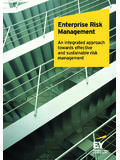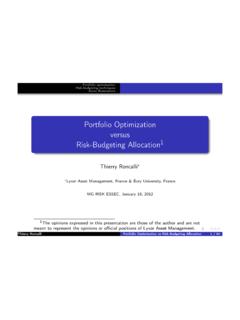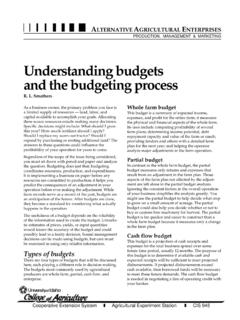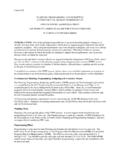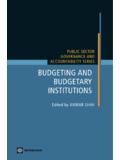Transcription of Effective Project Planning, Budgeting, and Risk …
1 20 April 2009 AWEA 09 Technical Papers Company Private 1 of 12 Effective Project planning , budgeting , and risk assessment for Offshore Wind Farm Installation and Marine Operations By Don Welch (3U Technologies, LLC) and Tim Axelsson (3U Technologies, LLC) Abstract: Effective planning and budgeting is critical to the economic viability of an offshore wind Project . With ship and fuel costs at all time highs, the cost versus reward benefit of Effective planning can become very significant, very quickly. Marine assets are demand driven and current demand is very high. This demand is primarily driven by the unprecedented boom in the oil and gas industry and the current high operational tempo in the submarine cable industry. Offshore vessel demand is projected to remain high even with 800+ vessels coming out of the shipyards over the next 24 months. Operational costs, asset availability, and market drivers as well as the trends and market projections for the next 3 5 years, are all factors which must be assessed.
2 Given this demand and high ship day rates Effective planning of offshore operations is imperative. Experience has proven that proper planning can significantly reduce the cost of operations and the associated operational risks . Risk based planning financial, technical, and schedule is key to the successful execution of offshore/underwater operations. Risk models should also include Life of Field Service (LOFS) impacts. This paper identifies and profiles the current cost and availability of different classes of marine assets needed to support offshore wind development and how these factors should be included in the Project development cycle and the budget process. Current day rates of $30K plus for support vessels to $100K plus for cable installation ships demand careful planning and management. INTRODUCTION Offshore wind development will be a key part of achieving energy security and independence for the US. The offshore advantages of increased power generation/concentration, power consistency and reliability, and proximity to major concentrations of users and the power grid cannot be ignored.
3 The challenges of working in the harsh offshore/underwater environment and the associated costs are critical factors which must be considered during the Project planning and budgeting cycles. The purpose of this paper is to present an approach for planning , budgeting and assessing the risks associated with the marine segments of an offshore wind farm development. This includes a discussion of operational costs, asset availability, and market drivers as well as the trends in the marine market. The impact of associated industries (oil and gas, submarine telecommunications) on the marine asset supply chain will also be examined. Project planning AND DEVELOPMENT PROCESS Figure 1 presents a top level overview of the Project development process for an offshore wind farm. The description of the development phases and how the Offshore Work Plan factors into the Project decision matrix is described. 20 April 2009 AWEA 09 Technical Papers Company Private 2 of 12 20 April 2009 AWEA 09 Technical Papers Company Private 3 of 12 OFFSHORE WORK PLAN The Offshore Work Plan is a key document that should be started during the Prefeasibility Study and becomes more detailed as the phases of the Project progress.
4 It examines the most cost Effective and efficient approach to the offshore work. There are a number of different approaches that can be taken and depending on the specific Project characteristics significant savings can be realized as the approach is optimized. The main segments of the offshore work plan are: Installation planning . This segment of the plan addresses how the turbine systems are to be installed and how the installation marine assets can be leveraged to make the other segments more cost Effective . One of the major goals is to maximize the opportunities to perform as many of the offshore operations as possible in parallel. Site Survey. The site survey plan examines the geomorphology of the potential site(s) and sediment composition. This information is critical to the foundation designs and the sea to shore subsea transmission cable plan. Desktop Study. The Desktop Study (DTS) is the critical part of the installation planning process whereby the marine cable route and subsea sites are technically evaluated based on available public information.
5 Critical criteria such as permitting, environmental conditions, tidal conditions, weather conditions, local government agencies for permitting, fishing activity, etc., are all part of the analysis provided in the DTS. The DTS is integral with the Site Survey but includes a much broader scope. Sea to Shore Connection Plan. This plan addresses th e elements required to transmit the generated power to shore. As will be discussed below when the insurance claim history associated with the European offshore wind industry is examined subsea cable issues comprise 80% of the claims paid. Lessons learned strongly indicate that developers should focus more resources on getting the Sea to Shore connection right. Schedule planning . The offshore work will be a significant factor in the overall schedule of the Project . Operational weather windows must be considered within the master schedule. It is critical to optimize the time of the year in which the offshore activities will be performed in order to minimize the weather down time.
6 The biggest costs associated with the offshore operation are the day rates of the marine assets which are payable whether the asset is working or on stand by waiting for the weather to clear. Operations and Maintenance planning . This segment of the plan deals with the Life of Field Service (LOFS) issues associated with a Project . The requirements to operate and maintain an offshore wind farm are very different and much more costly than on shore installations. Offshore Operations Risk Analysis. It is critical to identify the risks associated with the offshore work and be pro active in mitigating them. risks associated with marine asset availability, support infrastructure, weather, subsea sediment conditions, and installation are huge cost drivers. While the risk associated with offshore operations can never be mitigated completely it is paramount that they be mitigated to the ex tent possible and reasonable. In summary, the Offshore Work Plan should be a dynamic document that becomes progressively more detailed as the Project phases advance.
7 In addition, it is critical that planning for offshore operations be started 20 April 2009 AWEA 09 Technical Papers Company Private 4 of 12 early and continues throughout the Project . This approach allows the developer the opportunity to significantly reduce development costs and maximize Return on Investment (ROI). PREFEASIBILITY STUDY The Prefeasibility Study is the phase where the first, top level decisions concerning the Project are made. Once it has been determined that the wind resources and initial permission requirements are acceptable the Prefeasibility Study can proceed. The top level elements of this phase are shown in Figure 1. Other elements are included as required. The Initial Offshore Work Plan should be established in this phase. The key characteristic of this initial plan is to examine the available subsea and environmental data to attain a first look at the offshore work conditions: Installation planning .
8 Location of marine assets and transit ti mes can be major cost drivers which must be considered and accounted for in the original budget. In addition, an analysis of the operational weather window that can reasonably be expected versus weather associated down time is examined. Site Survey. Existing geophysical and bathymetric data provides details of the bottom morphology, sediment composition, depth of the bedrock layer, ocean current, tidal fluctuations, expected sea states, existing subsea cables and pipelines, shipping transit lanes, fishery patterns and habitats, and other information that can enter into the initial siting decisions. Environmental conditions can vary significantly over a relatively small area and the proper site selection to minimize installation costs is critical. Desktop Study. It is during the Prefeasibility Study that the DTS takes its initial form. All of the required elements are identified and the risk elements identified.
9 During this phase all of the available information is examined in order to formulate an initial assessment of the offshore requirements of the Project . Critical criteria such as permitting, environmental conditions, tidal conditions, weather conditions, local government agencies for permitting, fishing activity, fishermen groups, social conditions, etc., are all part of the analysis provided in the DTS. Subsea and Ocean Engineering. The engineering required during the Prefeasibility phase focuses mainly on identifying all of the major engineering elements which must be addressed, identifying the associated top level risks , and performing of initial trade offs to determine the best approach. During this phase the engineers maximize the use of existing information to establish th e initial engineering baseline. This includes all elements of the Project including offshore power consolidation, subsea engineering of the cable and protection plans, terminations and intra tower connectivity.
10 Sea to Shore Connection planning . Available survey data can provide an initial cable routing and protection plan. The cable and its i nstallation are major budget and schedule drivers with long lead times. Early planning will allow for these high impact components to be minimized and provide the basis for a realistic budget. In addition, it may be more Effective to plan for transmitting the power subsea versus over terrestrial routes. There are cross over points where subsea transmission is more cost Effective . Schedule planning . Schedule planning addresses operational weather windows 20 April 2009 AWEA 09 Technical Papers Company Private 5 of 12 and how to plan the offshore work in the most efficient manner. For instance, if the number of towers to be installed at a given location requires installation to occur over two weather seasons this could impact how the field is phased and brought on line.


